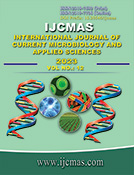


 National Academy of Agricultural Sciences (NAAS)
National Academy of Agricultural Sciences (NAAS)

|
PRINT ISSN : 2319-7692
Online ISSN : 2319-7706 Issues : 12 per year Publisher : Excellent Publishers Email : editorijcmas@gmail.com / submit@ijcmas.com Editor-in-chief: Dr.M.Prakash Index Copernicus ICV 2018: 95.39 NAAS RATING 2020: 5.38 |
The potato (Solanum tuberosum L.) remains an essential crop in addressing the world's food problems. Due to advancements in agricultural machinery, the use of fertilisers, and irrigation techniques, the crop's output has seen a tremendous increase globally in recent decades. However, every year, a sizeable amount of this essential crop suffers heavy loss because of various fungal, viral, bacterial, and nematode infestations affecting it. One such infection, Late blight, caused by Phytophthora infestans, is among the most dreaded diseases of potato globally which causes substantial production losses. In 19th century, the Irish Famine in the middle was caused by late blight. The pathogen has a wide range of variation and may adjust to newly developed varieties and fungicides. The pathogen infects all plant growth stages that show symptoms of late blight, tuber and stem rot and can lead to 100 percent yield loss. Humans are affected by late blight because the leafy stage restricts tuber production, infections on tubers eliminate a potential food supply. Numerous management strategies for late blight have been developed and are in use globally. Implementing an integrated disease management strategy is necessary for the disease's effective control. This review focused on prevalence, life cycle of Late blight caused by Phytophthora infestans and also emphasized on its management including various strategies, such as integrated disease management, chemical control, and cultural control.
 |
 |
 |
 |
 |